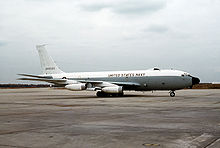From Wikipedia, the free encyclopedia
| NC-135 / NKC-135 | |
|---|---|
 |
|
| NKC-135A Airborne Laser Lab | |
| Role | Special test missions aircraft |
| National origin | United States |
| Manufacturer | Boeing |
| Status | In service |
| Primary users | United States Air Force United States Navy |
| Developed from | Boeing C-135 Stratolifter Boeing KC-135 Stratotanker |
Contents
Operational history
Readiness Program
In support of the U.S. Test Readiness Program that was initiated in response to the Limited Test Ban Treaty (LTBT) of 1963, Sandia National Laboratories configured three NC-135 aircraft as flying laboratories to support atmospheric testing of nuclear weapons, should testing have resumed. These aircraft were based at Kirtland Air Force Base. Work was initiated in 1963 and the aircraft remained in service until 1976, flying principally for Sandia, the Los Alamos National Laboratory and the Lawrence Livermore National Laboratory.[1] The Atomic Energy Commission (AEC) maintained controlling oversight of the NC-135 flight test aircraft. After 1976, the aircraft flew for Air Force Weapons Laboratory.[2]Airborne astronomy missions
The first eclipse mission took place from Pago Pago in 1965, and flying in conjunction with several other science aircraft, one of the NC-135s managed to fly within eclipse totality for 160 seconds, providing valuable science data. Eclipse missions were also flown in 1970, 1972, 1973, 1979 and 1980.[2]
Big Crow
Big Crow is the designation of the two NKC-135 test-bed aircraft (55-3132 and 63-8050) heavily modified for electronic warfare testing, and to be used as a target simulator for flight testing the Boeing YAL-1 Airborne Laser (ABL).[4] On March 15, 2007, the YAL-1 successfully fired this laser in flight, hitting its target. The target was the NKC-135E Big Crow 1 test aircraft that has been specially modified with a "signboard" target on its fuselage. The test validated the system's ability to track an airborne target and measure and compensate for atmospheric distortion.[5]Big Crow aircraft are also used as downrange telemetry assets in conjunction with Western Launch and Test Range launches from Vandenberg Air Force Base in California.[6]
The Big Crow Program Office is coming to an end after over 30 years serving the US and its allies. The two Big Crow aircraft now rest in the storage at Davis-Monthan AFB, awaiting possible dismantling in 2009. However, pending congressional legislation in 2009 may result in the aircraft being conveyed to a private civilian entity for continued R&D efforts.
Other versions
One aircraft, serial 61-2666, has been modified as an NC-135W to test systems and equipment used on RC-135V and W Rivet Joint reconnaissance aircraft.[7][8]From 1975 to 1984, the US used an NKC-135 for its Airborne Laser Lab program. The modified NKC-135A carried 10.6 micrometer green diode laser. Tests included successful interceptions of small air-to-air missiles such as the AIM-9 Sidewinder and drone aircraft. Despite the combat potential of the system, it was kept strictly experimental. However, the SCUD threat faced during the Gulf War reignited interest in an airborne laser system, resulting in the Boeing YAL-1.[9][10]
Operators
Survivors
- Since 1984 NKC-135 Airborne Laser Lab has been on display at the National Museum of the United States Air Force in Dayton, Ohio. In August 2011 it was removed from display in the Museum's Air Park to make room for the arrival of the Museum's C-5A Galaxy. The Museum is currently attempting to locate a new home for the aircraft, otherwise the aircraft will likely be scrapped.
Specifications (C-135)
General characteristics- Crew: 3: pilot, copilot, boom operator (4 for non-PACER CRAG aircraft)
- Length: 136 ft 3 in (41.53 m)
- Wingspan: 130 ft 10 in (39.88 m)
- Height: 41 ft 8 in (12.70 m)
- Wing area: 2,433 ft² (226 m²)
- Empty weight: 98,466 lb (44,663 kg)
- Loaded weight: 297,000 lb (135,000 kg)
- Max. takeoff weight: 322,500 lb (146,000 kg)
- Powerplant: 4 × (R/T) CFM International CFM-56 turbofan engines, 21,634 lbf (96 kN) each , 18,000 lbf (80 kN) each
- Maximum speed: 580 mph (933 km/h)
- Range: 3,450 mi (5,550 km)
- Service ceiling: 50,000 ft (15,200 m)
- Rate of climb: 4,900 ft/min (1,490 m/min)
See also
- Related development
- Boeing 367-80
- Boeing C-135 Stratolifter
- Boeing KC-135 Stratotanker
- Boeing EC-135
- Boeing RC-135
- OC-135B Open Skies
- WC-135 Constant Phoenix
- C-137 Stratoliner
- Boeing 707
- Aircraft of comparable role, configuration and era



No comments:
Post a Comment